Crop Productivity, Nutritional and Economic Benefits of No-Till Systems in Smallholder Farms of Ethiopia
Abstract
:1. Introduction
2. Materials and Methods
2.1. Description of Experimental Sites
2.2. Experimental Design and Treatment Description
- i.
- Conventional practice (CP): land preparation involved ploughing 3–4 times using an ox-drawn Maresha traditional plough before the onset of the rains. The fifth ploughing operation was conducted at planting after receiving effective rains.
- ii.
- No-till (NT): the soil was not tilled before planting the two test crops. Maize planting and basal fertilizer application were done using a two-row planter (model 2 CYF-2) that was powered by a 20 HP two-wheel tractor. The 2-BFG-100 (Dongfeng brand) planter was used for wheat direct seeding at all sites every growing season.
2.3. Experimental Management
2.4. Data Collection
2.4.1. Soil Analysis
2.4.2. Crop Productivity Variables
2.4.3. System Nutritional Value
2.4.4. Economic Analysis
2.5. Statistical Analyses
3. Results
3.1. Soil Properties
3.2. Crop Productivity
3.2.1. Maize Productivity
3.2.2. Wheat Productivity
3.3. System Nutritional Value
3.4. Gross Margins from Maize and Wheat Cropping Systems
4. Discussion
4.1. Crop Productivity and Nutritional Gains
4.1.1. Maize Productivity and Nutritional Gains
4.1.2. Wheat Productivity and Nutritional Gains
4.2. Gross Margins from Maize and Wheat Systems
5. Conclusions
Supplementary Materials
Author Contributions
Funding
Institutional Review Board Statement
Informed Consent Statement
Data Availability Statement
Acknowledgments
Conflicts of Interest
References
- Kassie, B.T.; Van Ittersum, M.K.; Hengsdijk, H.; Asseng, S.; Wolf, J.; Rötter, R.P. Climate-induced yield variability and yield gaps of maize (Zea mays L.) in the Central Rift Valley of Ethiopia. Field Crops Res. 2014, 160, 41–53. [Google Scholar] [CrossRef]
- Assefa, E. Characterization and Classification of the Major Agricultural Soils in CASCAPE Intervention Woredas in the Central Highlands of Oromia Region, Ethiopia. Ph.D. Thesis, Cascape-Addis Ababa University, Addis Ababa, Ethiopia, 2015; 131p. [Google Scholar]
- Silva, J.V.; Baudron, F.; Reidsma, P.; Giller, K.E. Is labour a major determinant of yield gaps in sub-Saharan Africa? A study of cereal-based production systems in Southern Ethiopia. Agric. Syst. 2019, 174, 39–51. [Google Scholar] [CrossRef]
- Mann, M.; Warner, J. Ethiopian wheat yield and yield gap estimation: A small area integrated data approach. Field Crops Res. 2017, 201, 60–74. [Google Scholar] [CrossRef] [PubMed] [Green Version]
- Abebe, Z.; Birhanu, T.; Shiferaw, T.; Degefa, K. Conservation agriculture: Maize-legume intensification for yield, profitability and soil fertility improvement in maize belt areas of western Ethiopia. Int. J. Plant Soil Sci. 2014, 3, 969–985. [Google Scholar]
- CIMMYT. Ethiopian Experts Push for Wheat Self-Sufficiency. Available online: https://www.cimmyt.org/news/ethiopian-experts-push-for-wheat-self-sufficiency/ (accessed on 14 March 2020).
- World Population Prospects. Ethiopia Population. Available online: https://worldpopulationreview.com/countries/ethiopia-population/ (accessed on 14 March 2020).
- Demeke, M.; Marcantonio, F.D. Analysis of incentives and disincentives for wheat in Ethiopia. In Monitoring African Food and Agricultural Policies (MAFAP); MAPA: Rome, Italy, 2013. [Google Scholar]
- Mupangwa, W.; Wegary, D. Closing the gap between the potential yield and obtained results of improved maize varieties: Case for Ethiopia. In Proceedings of the African Seed Trade Association, Cairo, Egypt, 27 February–1 March 2018. [Google Scholar]
- Baudron, F.; Sims, B.; Justice, S.; Kahan, D.G.; Rose, R.; Mkomwa, S.; Kaumbutho, P.; Sariah, J.; Nazare, R.; Moges, G.; et al. Re-examining appropriate mechanization in Eastern and Southern Africa: Two-wheel tractors, conservation agriculture, and private sector involvement. Food Secur. 2015, 7, 889–904. [Google Scholar] [CrossRef]
- Mutyasira, V.; Hoag, D.; Pendell, D.; Manning, D.T.; Berhe, M. Assessing the relative sustainability of smallholder farming systems in Ethiopian highlands. Agric. Syst. 2018, 167, 83–91. [Google Scholar] [CrossRef]
- Baudron, F.; Misiko, M.; Getnet, B.; Nazare, R.; Sariah, J.; Kaumbutho, P. A farm-level assessment of labor and mechanization in Eastern and Southern Africa. Agron. Sustain. Dev. 2019, 39, 17. [Google Scholar] [CrossRef] [Green Version]
- Van Eerdewijk, A.; Danielsen, K. Gender Matters in Farm Power; KIT: Amsterdam, The Netherlands, 2015. [Google Scholar] [CrossRef]
- Mrema, G.C.; Baker, D.; Kahan, D. Agricultural Mechanization in Sub-Saharan Africa: Time for a New Look. In Agricultural Management, Marketing and Finance; FAO: Rome, Italy, 2008; p. 70. [Google Scholar]
- Kahan, D.; Bymolt, R.; Zaal, F. Thinking outside the plot: Insights on small-scale mechanisation from case studies in East Africa. J. Dev. Stud. 2017, 54, 1939–1954. [Google Scholar] [CrossRef]
- Nyagumbo, I.; Mkuhlani, S.; Mupangwa, W.; Rodriguez, D. Planting date and yield benefits from conservation agriculture practices across Southern Africa. Agric. Ecosyst. Environ. 2017, 150, 21–33. [Google Scholar] [CrossRef]
- Fuentes-Llanillo, R.; Telles, T.S.; Volsi, B.; Soares, D.; Carneiro, S.L.; De Fátima Guimarães, M. Profitability of no-till grain production systems. Semin. Agrar. 2018, 39, 77–86. [Google Scholar] [CrossRef]
- González-Sánchez, E.J.; Mkomwa, S.; Conway, G.; Kassam, A.; Fernández, R.O.; Moreno-García, M.; Torres, M.R.R.; Gil-Ribes, J.A.; Basch, G.; Veroz-González, O.; et al. Making Climate Change Mitigation and Adaptability Real in Africa with Conservation Agriculture; African Conservation Tillage Network (ACT): Nairobi, Kenya; European Conservation Agriculture Federation (ECAF): Brussels, Belgium, 2018. [Google Scholar] [CrossRef]
- Nunes, M.R.; van Es, H.M.; Schindelbeck, R.; Ristow, A.J.; Ryan, M. No-till and cropping system diversification improve soil health and crop yield. Geoderma 2018, 328, 30–43. [Google Scholar] [CrossRef]
- Nezomba, H.; Mtambanengwe, F.; Rurinda, J.; Mapfumo, P. Integrated soil fertility management sequences for reducing climate risk in smallholder crop production systems in southern Africa. Field Crops Res. 2018, 28, 102–114. [Google Scholar] [CrossRef]
- Nezomba, H.; Mtambanengwe, F.; Tittonell, P.; Mapfumo, P. Geoderma point of no return? Rehabilitating degraded soils for increased crop productivity on smallholder farms in eastern Zimbabwe. Geoderma 2015, 239–240, 143–155. [Google Scholar] [CrossRef]
- Vanlauwe, B.; Hungria, M.; Kanampiu, F.; Giller, K.E. The role of legumes in the sustainable intensification of African smallholder agriculture: Lessons learnt and challenges for the future. Agric. Ecosyst. Environ. 2019, 284, 106583. [Google Scholar] [CrossRef]
- Ngwira, A.; Aune, J.B.; Mkwinda, S. On-farm evaluation of yield and economic benefit of short term maize legume intercropping systems under conservation agriculture in Malawi. Field Crops Res. 2012, 132, 149–157. [Google Scholar] [CrossRef]
- Thierfelder, C.; Matemba-Mutasa, R.; Rusinamhodzi, L. Yield response of maize (Zea mays L.) to conservation agriculture cropping system in Southern Africa. Soil Tillage Res. 2015, 146, 230–242. [Google Scholar] [CrossRef]
- Liben, F.M.; Tadesse, B.; Tola, Y.T.; Wortmann, C.S.; Kim, H.K.; Mupangwa, W. Conservation agriculture effects on crop productivity and soil properties in Ethiopia. Agron. J. 2018, 110, 758–767. [Google Scholar] [CrossRef]
- Ngwira, A.; Thierfelder, C.; Lambert, D.M. Conservation agriculture systems for Malawian smallholder farmers: Long-term effects on crop productivity, profitability and soil quality. Renew. Agric. Food Syst. 2012, 28, 350–363. [Google Scholar] [CrossRef] [Green Version]
- Mupangwa, W.; Mutenje, M.; Thierfelder, C.; Nyagumbo, I. Are conservation agriculture (CA) systems productive and profitable options for smallholder farmers in different agro-ecoregions of Zimbabwe? Renew. Agric. Food Syst. 2016, 32, 87–103. [Google Scholar] [CrossRef]
- Mupangwa, W.; Mutenje, M.; Thierfelder, C.; Mwila, M.; Malumo, H.; Mujeyi, A.; Setimela, P. Productivity and profitability of manual and mechanized conservation agriculture systems in eastern Zambia. Renew. Renew. Agric. Food Syst. 2017, 34, 380–394. [Google Scholar] [CrossRef]
- Mutenje, M.J.; Farnworth, C.R.; Stirling, C.; Thierfelder, C.; Mupangwa, W.; Nyagumbo, I. A cost-benefit analysis of climate-smart agriculture options in Southern Africa: Balancing gender and technology. Ecol. Econ. 2019, 163, 126–137. [Google Scholar] [CrossRef]
- Kahan, D.; Benesta, T.; Matangi, D.; Tadesse, E. Agricultural Mechanization and Small-Scale Agriculture: Case Study Evidence from Eastern and Southern Africa; ACT Working Paper: Nairobi, Kenya, 2016; p. 28. [Google Scholar]
- Yahaya, R.; Tadesse, E.; Mupangwa, W. Appropriate Agricultural Mechanization for Increased Crop Productivity and Income Generation in Rural Ethiopia. In Proceedings of the Global Food Security and Food Safety: The Role of Universities, International Conference on Research on Food Security, Natural Resource Management and Rural Development, Ghent, Belgium, 17–19 September 2018; Margraf Publishers GmbH: Weikersheim, Germany; p. 558.
- Terefe, R.; Lemma, B. Soil chemical property variation under different conservation agriculture practices, in Bako Tibe district, West Shoa, Ethiopia. Int. J. Plant Soil Sci. 2019, 29, 1–8. [Google Scholar] [CrossRef] [Green Version]
- Abebe, S.A. Application of time series analysis to annual rainfall values in Debre Markos town, Ethiopia. Comput. Water Energy Environ. Eng. 2018, 7, 81–94. [Google Scholar] [CrossRef] [Green Version]
- Yumbya, J.; Maria, D.; Vaate, B.D.; Kiambi, D.; Kebebew, F.; Rao, K.P.C. Assessing the Effects of Climate Change on Teff in Ethiopia: Implications for Food Security; Technical Report: Nairobi, Kenya, 2014. [Google Scholar]
- Kuria, A.; Lamond, G.; Pagella, T.; Gebrekirstos, A.; Sinclair, F. Local Knowledge of Farmers on Opportunities and Constraints to Sustainable Intensification of Crop-Livestock-Trees Mixed Systems in Basona Woreda, Amhara Region, Ethiopian Highlands; Addis Ababa, Ethiopia. 2013. Available online: https://cgspace.cgiar.org/bitstream/handle/10568/41669/Lemo_ARmay.pdf?sequence=1&isAllowed=y (accessed on 16 June 2020).
- Getahun, M.; Selassie, Y.G. Characterisation, classification and mapping of soils of Agricultural landscape in Tana basin, Amhara national regional state, Ethiopia. In Social and Ecological System Dynamics: Characteristics, Trends, and Integration in the Lake Tana Basin, Ethiopia; Stave, K., Goshu, G., Aynalem, S., Eds.; Springer, Technology Engineering: Cham, Switzerland, 2017; p. 652. [Google Scholar]
- Gala, T.; Pazner, M.; Beyene, S. Evaluating biophysical attributes of environmentally degraded landscapes in Northern Ethiopia using LANDSAT ETM data and GIS. Ethiop. J. Environ. Stud. Manag. 2011, 4, 1–16. [Google Scholar] [CrossRef]
- Anderson, J.M.; Ingram, J.S. Tropical Soil Biology and Fertility: A Handbook of Methods; CAB International: Oxfordshire, UK, 1993; p. 250. [Google Scholar]
- Mehlich, A. Mehlich 3 soil test extractions: A modification of Mehlich 2 extractant. Commun. Soil Sci. Plant Anal. 1984, 15, 1409–1416. [Google Scholar] [CrossRef]
- CIMMYT. An Economics Training Manual: From Agronomic Data to Farmer Recommendations; Revised ed.; CIMMYT: Mexico City, Mexico, 1988; p. 63. [Google Scholar]
- Core-Team. R: A Language and Environment for Statistical Computing; R Foundation for Statistical Computing: Vienna, Austria, 2020; Available online: https://www.R-project.org/ (accessed on 21 October 2020).
- Abate, T.; Shiferaw, B.; Menkir, A.; Wegary, D.; Kebede, Y.; Tesfaye, K.; Kassie, M.; Bogale, G.; Tadesse, B.; Keno, T. Factors that transformed maize productivity in Ethiopia. Food Secur. J. 2015, 7, 965–981. [Google Scholar] [CrossRef] [Green Version]
- Cadot, S.; Bélanger, G.; Ziadi, N.; Morel, C.; Sinaj, S. Critical plant and soil phosphorus for wheat, maize, and rapeseed after 44 years of P fertilization. Nutr. Cycl. Agroecosyst. 2018, 112, 417–433. [Google Scholar] [CrossRef] [Green Version]
- Getnet, M.; Van Ittersum, M.; Hengsdijk, H.; Descheemaeker, K. Yield gaps and resource use across farming zones in the central Rift valley of Ethiopia. Exp. Agric. 2016, 52, 493–517. [Google Scholar] [CrossRef]
- Assefa, B.T.; Chamberlin, J.; Reidsma, P.; Silva, J.V.; van Ittersum, M.K. Correction to: Unravelling the variability and causes of smallholder maize yield gaps in Ethiopia. Food Secur. 2020, 12, 83–103. [Google Scholar] [CrossRef]
- Van Dijk, M.; Morley, T.; Jongeneel, R.; van Ittersum, M.; Reidsma, P.; Ruben, R. Disentangling agronomic and economic yield gaps: An integrated framework and application. Agric. Syst. 2017, 154, 90–99. [Google Scholar] [CrossRef]
- Thierfelder, C.; Baudron, F.; Setimela, P.; Nyagumbo, I.; Mupangwa, W.; Mhlanga, B.; Lee, N.; Gérard, B. Complementary practices supporting conservation agriculture in southern Africa. A review. Agron. Sustain. Dev. 2018, 38, 16. [Google Scholar] [CrossRef] [Green Version]
- FAO. Food Energy-Methods of Analysis and Conversion Factors; Report of a Technical Workshop, Rome, 3–6 December 2002, (No. 77); FAO Food and Nutrition Paper: Rome, Italy, 2002; Available online: https://www.fao.org/3/y5022e/y5022e00.html (accessed on 14 March 2020).
- FAO. Human Energy Requirements; Report of a Joint FAO/WHO/UNU Expert consultation (No. 1); FAO Food and Nutrition technical Report: Rome, Italy, 2004; Available online: https://www.fao.org/3/y5686e/y5686e.pdf. (accessed on 14 March 2020).
- Dutta, S.; Chakraborty, S.; Goswami, R.; Banerjee, H.; Majumdar, K.; Li, B.; Jat, M.L. Maize yield in smallholder agriculture system—An approach integrating socio-economic and crop management factors. PLoS ONE 2020, 15, e0229100. [Google Scholar] [CrossRef] [PubMed]
- FAO. Integrated Plant Nutrition System; (No. 12); FAO Fertilizer and Plant Nutrition Bulletin: Rome, Italy, 1995; p. 424. Available online: https://www.fao.org/3/v5250e/v5250e.pdf (accessed on 14 March 2020).
- Ngwira, A.R.; Aune, J.B.; Thierfelder, C. On-farm evaluation of the effects of the principles and components of conservation agriculture on maize yield and weed biomass in Malawi. Exp. Agric. 2014, 50, 591–610. [Google Scholar] [CrossRef] [Green Version]
- Mkuhlani, S.; Mupangwa, W.; Macleod, N.; Gwiriri, L.; Nyagumbo, I.; Manyawu, G.; Chigede, N. Crop–livestock integration in smallholder farming systems of Goromonzi and Murehwa, Zimbabwe. Renew. Agric. Food Syst. 2018, 35, 1–12. [Google Scholar] [CrossRef]
- Thierfelder, C.; Matemba-Mutasa, R.; Bunderson, W.T.; Mutenje, M.; Nyagumbo, I.; Mupangwa, W. Evaluating manual conservation agriculture systems in southern Africa. Agric. Ecosyst. Environ. 2016, 222, 112–124. [Google Scholar] [CrossRef]
- Mupangwa, W.; Thierfelder, C.; Cheesman, S.; Nyagumbo, I.; Muoni, T.; Mhlanga, B.; Mwila, M.; Sida, T.S.; Ngwira, A. Effects of maize residue and mineral nitrogen applications on maize yield in conservation-agriculture-based cropping systems of Southern Africa. Renew. Agric. Food Syst. 2019, 35, 322–335. [Google Scholar] [CrossRef]
- Giller, K.E.; Andersson, J.A.; Corbeels, M.; Kirkegaard, J.; Mortensen, D.; Erenstein, O.; Vanlauwe, B. Beyond conservation agriculture. Front. Plant Sci. 2015, 6, 870. [Google Scholar] [CrossRef]
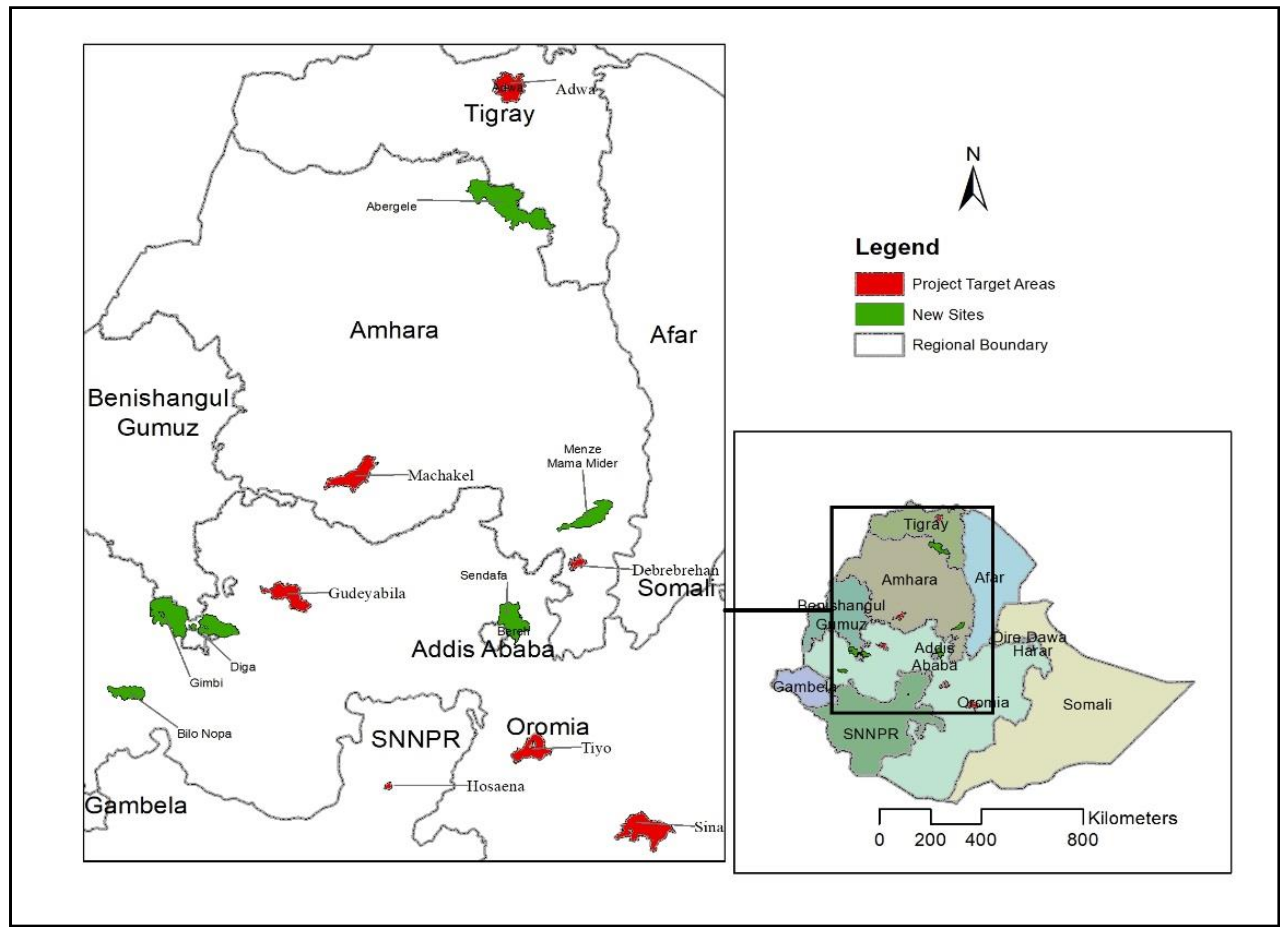

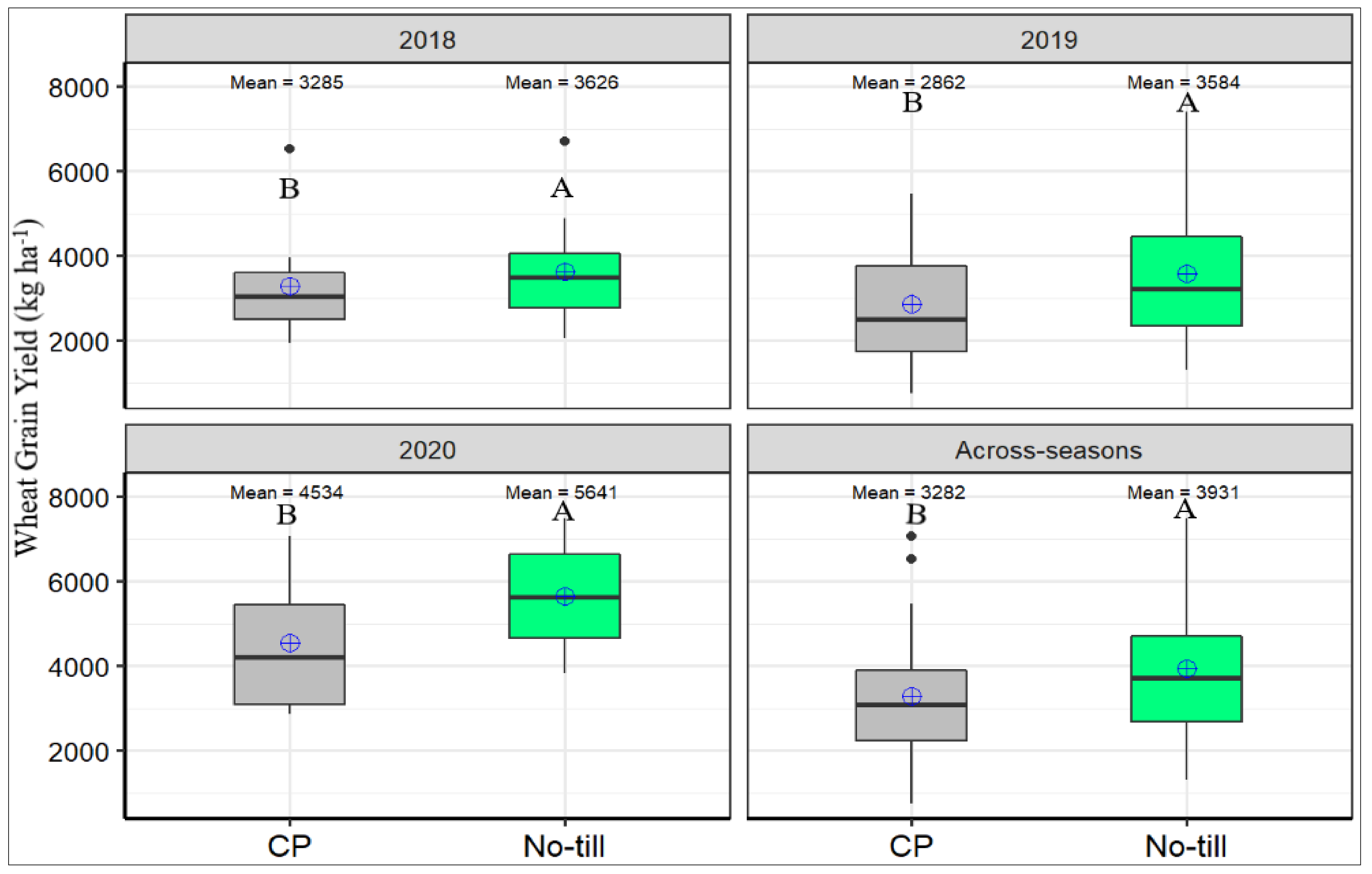
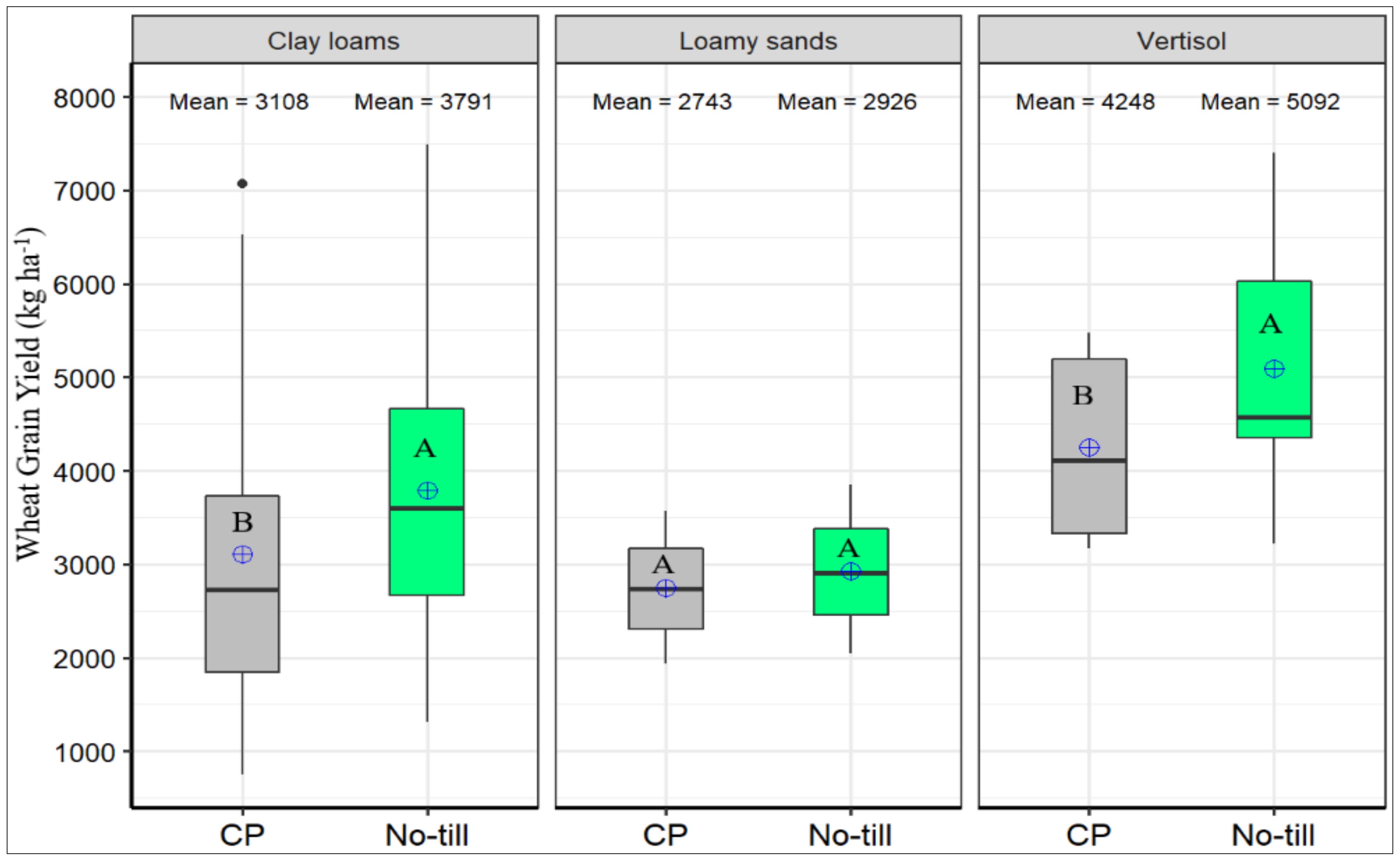
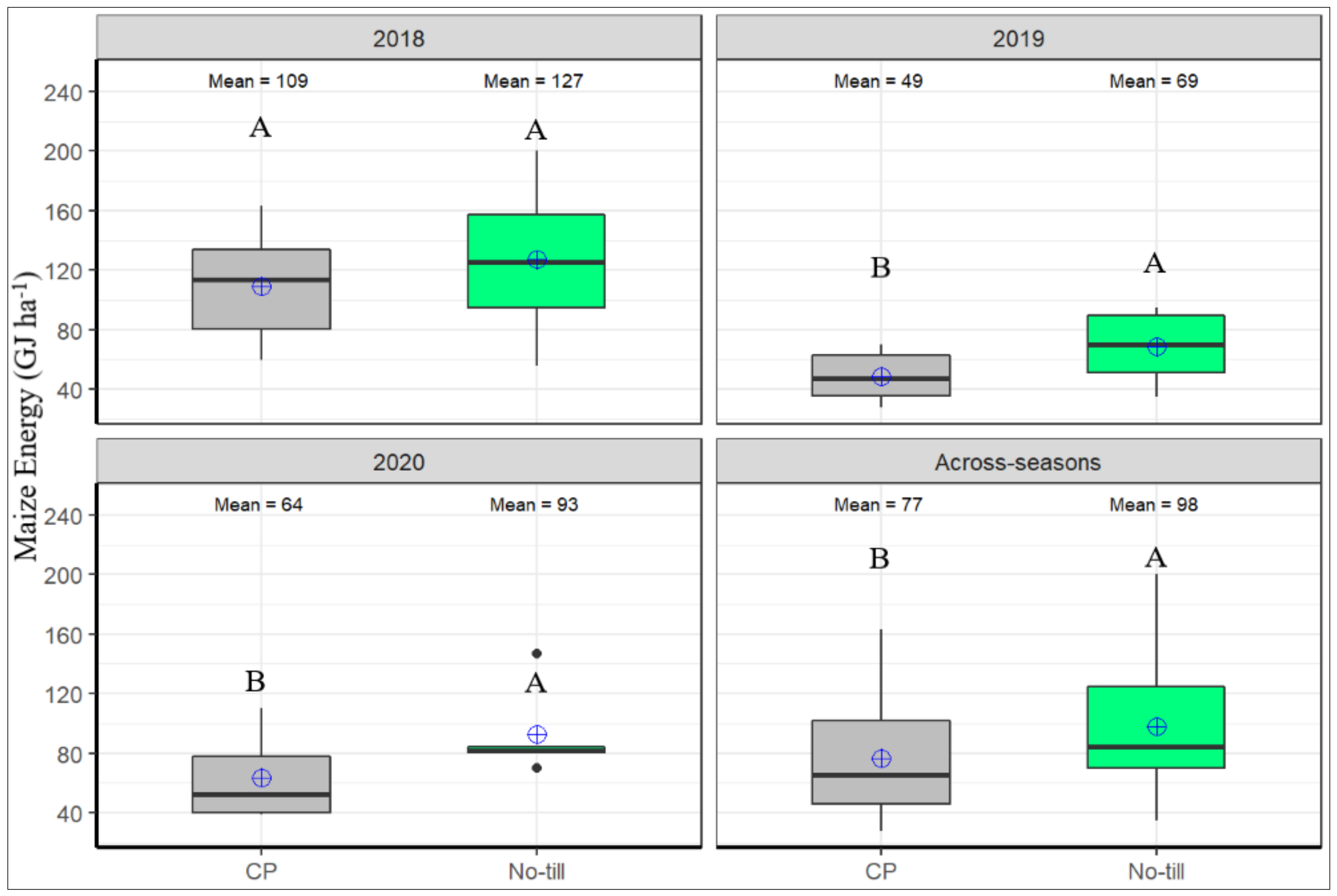
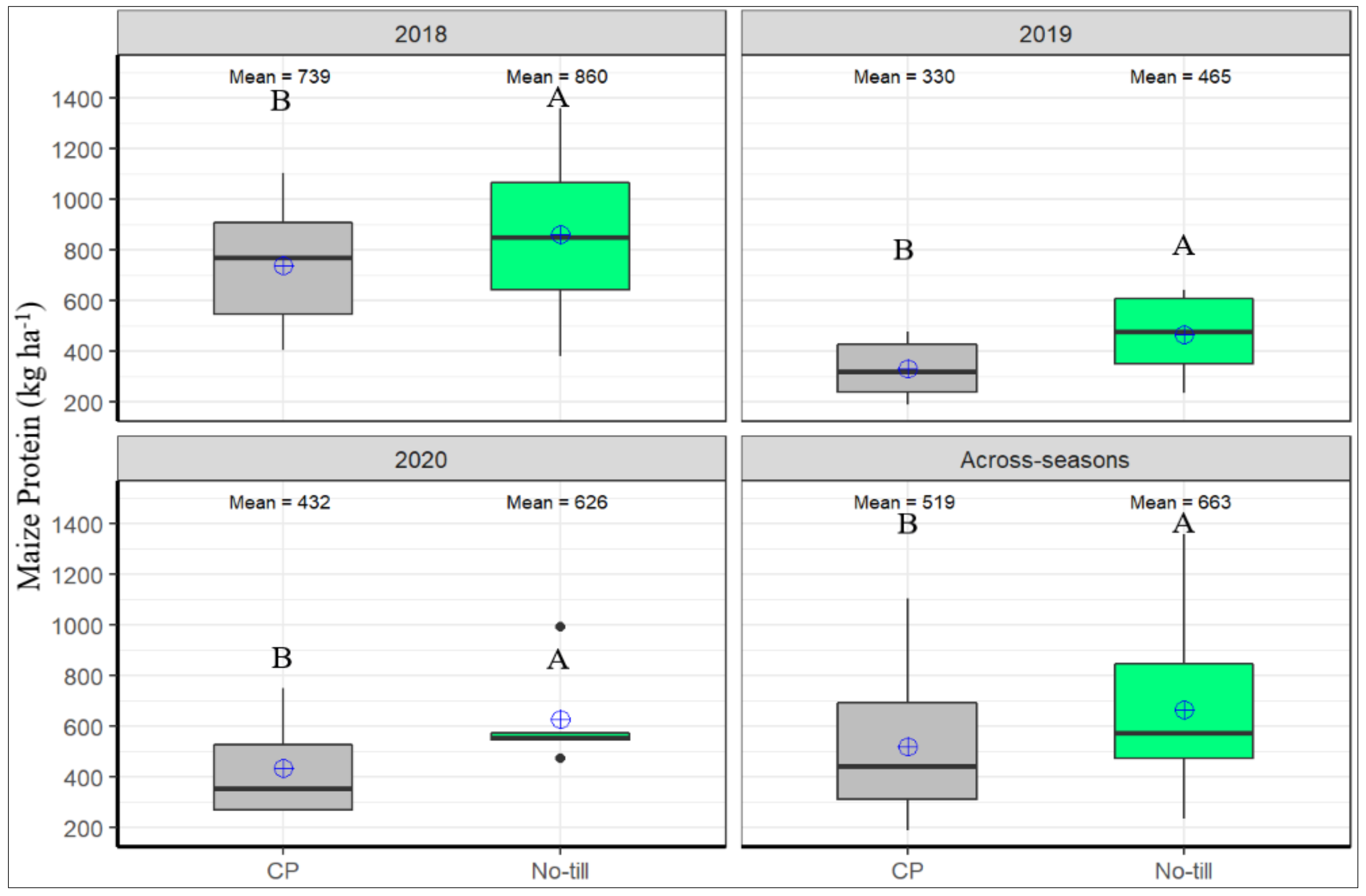



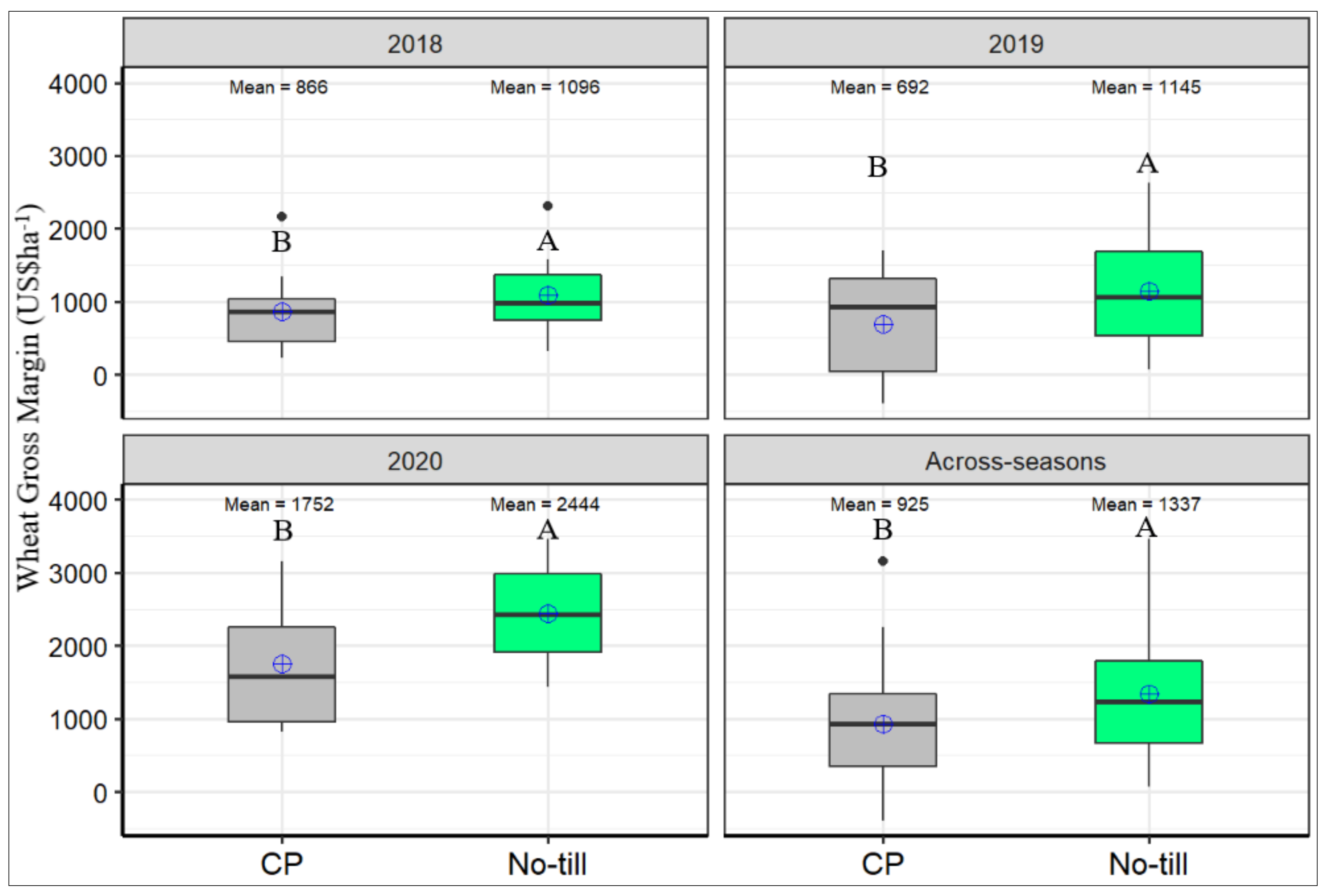
| Soil Property | Conventional Practice | No-Till |
|---|---|---|
| pH | 5.6 (0.44) | 5.7 (0.92) |
| Organic carbon (%) | 3.4 (0.07) | 3.8 (0.45) |
| Phosphorus (mg kg−1) | 4.7 (0.68) | 5.2 (0.09) |
| Sulphur (mg kg−1) | 8.5 (2.74) | 10.7 (3.27) |
| Zinc (mg kg−1) | 2.6 (0.29) | 3.5 (0.74) |
| Cation exchange capacity (mg kg−1) | 26.2 (0.57) | 26.9 (0.81) |
| Treatment | 2018 | 2019 | 2020 | Across Years | ||||||||
|---|---|---|---|---|---|---|---|---|---|---|---|---|
| Population | Stover | HI | Population | Stover | HI | Population | Stover | HI | Population | Stover | HI | |
| CP | 41,172 | 11,458 | 0.39 | 30,982 b | 5639 | 0.37 | 35,500 | 5014 | 0.47 | 37,337 b | 9126 | 0.34 |
| NT | 45,391 | 9232 | 0.49 | 37,946 a | 6568 | 0.41 | 42,000 | 5439 | 0.55 | 43,087 a | 9410 | 0.37 |
| p-value | ns | ns | ns | 0.0005 | ns | ns | ns | ns | ns | 0.0034 | ns | ns |
| SE | 2403 | 1452 | 0.067 | 1025 | 387 | 0.040 | 2508 | 506.6 | 0.033 | 1324 | 652.2 | 0.0244 |
| CV (%) | 11.1 | 28.1 | 30.3 | 5.56 | 16.8 | 19.1 | 14.2 | 21.2 | 14.3 | 14.1 | 30.0 | 29.3 |
| Treatment | 2018 | 2019 | 2020 | Across Years | ||||||||
|---|---|---|---|---|---|---|---|---|---|---|---|---|
| Straw | HI | HSW | Straw | HI | HSW | Straw | HI | HSW | Straw | HI | HSW | |
| CP | 3 243 b | 0.47 b | 4.0 | 6 245 | 0.31 b | 3.2 | 2811 | 0.62 a | 3.28 | 3071 b | 0.51 b | 3.50 |
| NT | 4 149 a | 0.51 a | 4.2 | 6 862 | 0.34 a | 3.7 | 3759 | 0.60 b | 3.32 | 3897 a | 0.54 a | 3.78 |
| p-value | 0.0026 | 0.0318 | ns | ns | 0.0074 | ns | ns | 0.0198 | ns | <0.001 | 0.0094 | ns |
| SE | 228 | 0.012 | 0.23 | 378 | 0.010 | 0.213 | 305.7 | 0.0034 | 0.1196 | 112.1 | 0.007 | 0.105 |
| CV (%) | 14.4 | 7.9 | 12.0 | 15.8 | 8.8 | 16.7 | 20.8 | 1.26 | 8.10 | 15.4 | 6.36 | 14.8 |
Disclaimer/Publisher’s Note: The statements, opinions and data contained in all publications are solely those of the individual author(s) and contributor(s) and not of MDPI and/or the editor(s). MDPI and/or the editor(s) disclaim responsibility for any injury to people or property resulting from any ideas, methods, instructions or products referred to in the content. |
© 2022 by the authors. Licensee MDPI, Basel, Switzerland. This article is an open access article distributed under the terms and conditions of the Creative Commons Attribution (CC BY) license (https://creativecommons.org/licenses/by/4.0/).
Share and Cite
Mupangwa, W.; Yahaya, R.; Tadesse, E.; Ncube, B.; Mutenje, M.; Chipindu, L.; Mhlanga, B.; Kassa, A. Crop Productivity, Nutritional and Economic Benefits of No-Till Systems in Smallholder Farms of Ethiopia. Agronomy 2023, 13, 115. https://doi.org/10.3390/agronomy13010115
Mupangwa W, Yahaya R, Tadesse E, Ncube B, Mutenje M, Chipindu L, Mhlanga B, Kassa A. Crop Productivity, Nutritional and Economic Benefits of No-Till Systems in Smallholder Farms of Ethiopia. Agronomy. 2023; 13(1):115. https://doi.org/10.3390/agronomy13010115
Chicago/Turabian StyleMupangwa, Walter, Rabe Yahaya, Ephrem Tadesse, Bongani Ncube, Munyaradzi Mutenje, Lovemore Chipindu, Blessing Mhlanga, and Abrham Kassa. 2023. "Crop Productivity, Nutritional and Economic Benefits of No-Till Systems in Smallholder Farms of Ethiopia" Agronomy 13, no. 1: 115. https://doi.org/10.3390/agronomy13010115






